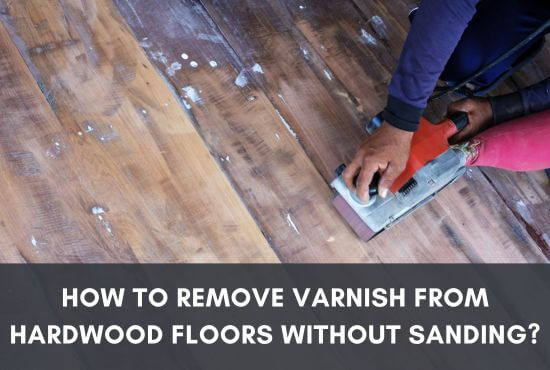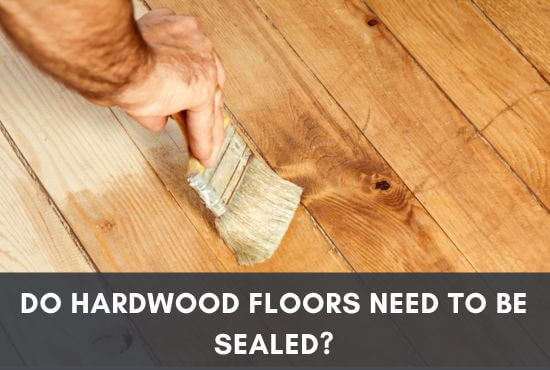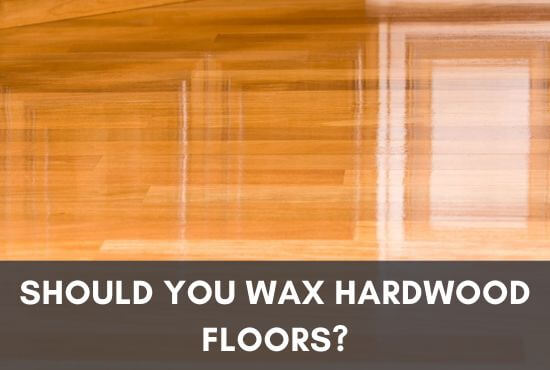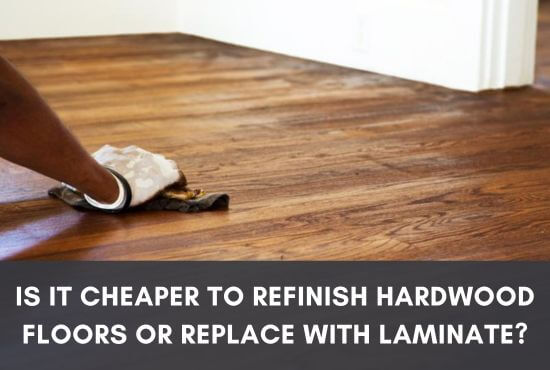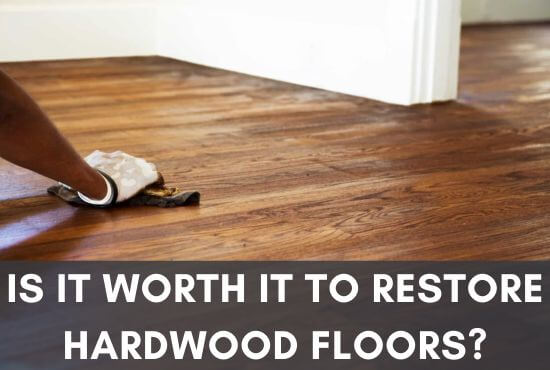Hardwood floors are ideal because they are durable, aesthetically pleasing, and comfortable to walk. It is the only flooring option that comes close to matching the variety of wooden surfaces.
Furthermore, nothing compares to the elegance of a polished, shiny wooden floor. Compared to tiles and concrete, wood is a more mechanically vulnerable substance.
You need a strong chemical to clean wooden surfaces without causing even the slightest damage. Here, your go-to substance, hydrogen peroxide, is used because it is ideal for the task.
Let hydrogen peroxide sit on the hardwood floor stain for approximately 6-8 minutes. Even if the stain doesn’t come out, make sure you don’t leave the solution on for longer than 10 minutes because the water may harm the wood if you do. Scrubbing with more power will be necessary to remove tough stains. After you’re done, your wooden floor should look clean and brand-new.

Let’s discuss the in-depth guide to using hydrogen peroxide on hardwood floors along with its stay duration on wooden surfaces.
Table of Contents
- 1 How Long Should Hydrogen Peroxide Sit On Hardwood Floors? | The After Effects
- 2 Removing Stains With Hydrogen Peroxide
- 3 Cleaning Hardwood Floors With Hydrogen Peroxide
- 4 Cleaning Fresh Pet Stains From Hardwood Floors
- 5 Cleaning Mud Stains from Hardwood Floors
- 6 Cleaning Food Stains from Hardwood Floors
- 7 Using Hydrogen Peroxide to Deodorize Hardwood Floors
- 8 Can Hydrogen Peroxide Be Used On All Surfaces?
- 9 Why You Should Use Hydrogen Peroxide on Hardwood Cleaning?
- 10 How Does Hydrogen Peroxide Work?
- 11 Can Hydrogen Peroxide Be Used With a Mop on Hardwood Floors?
- 12 Will Hydrogen Peroxide Damage Hardwood Floors?
- 13 Final Thoughts
How Long Should Hydrogen Peroxide Sit On Hardwood Floors? | The After Effects
It is essential to adhere carefully to the recommended concentrations and instructions because using powerful hydrogen peroxide products as a floor cleaner carries the risk of permanently lighting your wooden floors.
A spot test is required to prevent the wood’s hue from changing. Apply the 3% hydrogen peroxide uniformly and sparingly to the damaged floor using the spray bottle.
Use a microfiber cleaning towel to remove any excess solution after allowing the solution to sit for no longer than five minutes.
Hydrogen peroxide is suitable for use on wood floors because it is a safe cleaning agent for humans and animals and is effective when applied correctly.
Adding antibacterial, antiviral, and antifungal properties sanitizes your house and removes dirt and debris.
I have also written an article in which I have shared my best picks for hardwood floor cleaners. Don’t miss that out.
The cleaning capabilities of hydrogen peroxide are extraordinary. In many cases, It can eliminate stains on wood surfaces by applying hydrogen peroxide.
Hydrogen peroxide is used to sanitize and clean the timber; it can cut through even the most difficult stains and can loosen and remove dirt.
Wood can’t be treated with hydrogen peroxide directly. As it is a very strong chemical, it can cause damage to your wooden surfaces. Hence, it is necessary that the wood is treated with 10% ammonia at first.
Afterward, you can use your bleaching solution to wipe the floor or surface with it.
However, it is to be noted that if your wood is already light-colored or you fear that it would lighten a lot after bleaching, you must use an even less concentrated version of the compound.
Also Read: How Often Should You Clean Hardwood Floors (Revealed)
Removing Stains With Hydrogen Peroxide
Pet stains, mud, dirt, and virtually anything else can be removed from your floors with hydrogen peroxide, restoring their look.
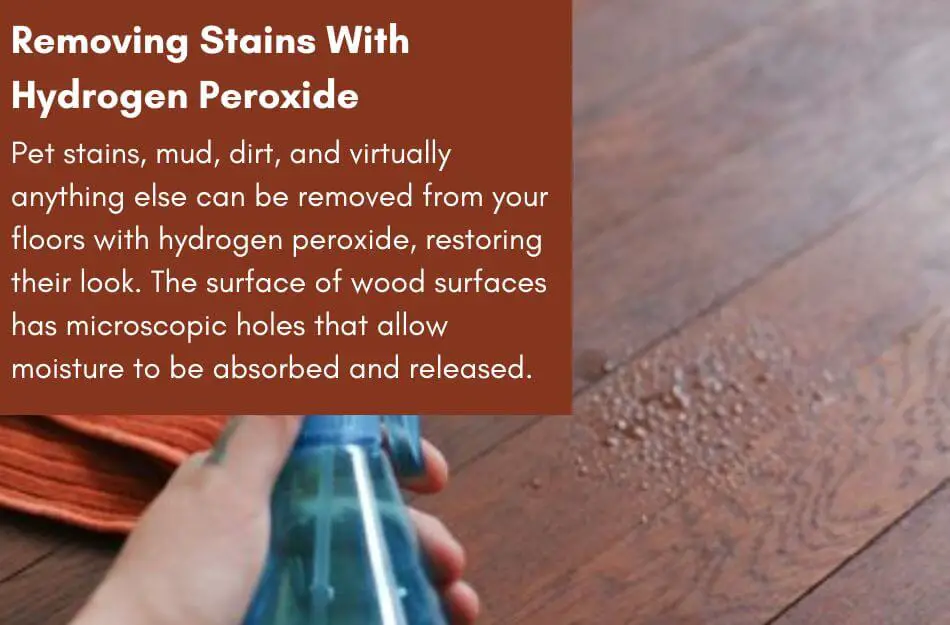
The surface of wood surfaces has microscopic holes that allow moisture to be absorbed and released. In humid environments, hardwood floor buckling is frequent due to moisture vapor in the material.
The pores are collecting too much moisture, causing them to buck. Wood surfaces can be difficult to clean because of the cause of stains on them.
Hydrogen peroxide is the best option because it dries the timber while removing the staining agents from it.
Cleaning Hardwood Floors With Hydrogen Peroxide
The finishes on hardwood floors are more delicate than they seem. Although you can’t readily damage the finish by stepping on it, you can diminish it using the incorrect cleaning solvent.
But hydrogen peroxide isn’t one of those, and it works well to clear stains. Pet spots, frequently the most difficult to remove, respond particularly well to peroxide treatment.
It is also an effective timber bleaching agent when used in the right concentration.
Make a Hydrogen Peroxide Solution
Since hydrogen peroxide is a mild oxygenating bleach, you can combine 1 cup of the cleaning-grade, 35 percent hydrogen peroxide solution with 1 gallon of water to create a safe floor-cleaning fluid for everyday use.
A gallon of hot water can be combined with one or two teaspoons of sodium percarbonate as an alternative.
It is simple to create a more concentrated peroxide solution using sodium percarbonate, which produces hydrogen peroxide when combined with water.
Check the label before buying one of these products. It is the primary component in many industrial oxygen bleach products.
You May Also Like: What Is The Cheapest Way To Clean Hardwood Floors?
Floor Cleaning Procedure
Wood flooring can be cleaned using a hydrogen peroxide formula and a mop or cloth. Too much water can damage hardwood (and vinyl wood-like flooring, too! ), so be sure to dry out the brush or towel so that it is only faintly damp.
Use a microfiber mop or a non-abrasive cloth instead of a natural fiber mop because the latter distributes too much water.
First, thoroughly clean or sweep the floor to eliminate all the grime, fur, crumbs, and other trash.
Next, clean the floor in parts without rinsing using your preferred hydrogen peroxide solution (from the list above).
Before proceeding to the following part:
- Dry it with a different rag.
- Pour 3% peroxide, the grade sold in drug shops, into a squeeze bottle and use it to clean small messes.
- Spray, brush, and dry.
Cleaning Fresh Pet Stains From Hardwood Floors
Pet urine can leave your carpeting with unsightly dark spots and unpleasant smells. It is best to clean as soon as the stain and odor appear; you can typically eliminate both with a solution of hydrogen peroxide and bicarbonate of soda.
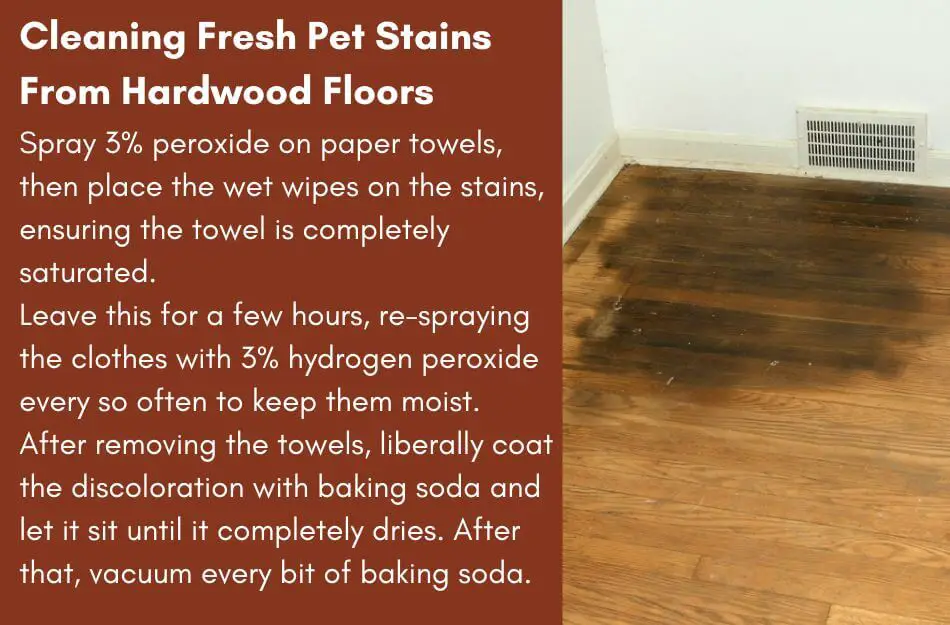
Spray 3% peroxide on paper towels, then place the wet wipes on the stains, ensuring the towel is completely saturated.
Leave this for a few hours, re-spraying the clothes with 3% hydrogen peroxide every so often to keep them moist.
After removing the towels, liberally coat the discoloration with baking soda and let it sit until it completely dries. After that, vacuum every bit of baking soda.
Cleaning Mud Stains from Hardwood Floors
The dust and sand collected on the hardwood floor and deposit are frequently mistaken for mud marks. The darkening of the timber that takes place beneath the deposit is what causes the real mud stain.
It’s simple to take the top’s solid, dried dirt off. One stroke and it is gone. The stain it creates on the wood is the true threat.
It comprises mud’s natural pigments, which are then transferred to wooden boards.
These pigments are mildly degraded by hydrogen peroxide without causing any harm to the timber. The chemical can quickly remove these stubborn mud stains thanks to its world-class oxidizing qualities!
If you want to clean hardwood floors without using any cleaners, here’s an ultimate guide on how to disinfect hardwood floors naturally.
Cleaning Food Stains from Hardwood Floors
Especially in the kitchen, food stains are the most frequent stains you’ll have to remove from your wooden floor.
Food stains can range from dark coffee stains to vivid crimson ketchup drippings. But all food stains share one trait in common.
They are made up of organic compounds and are very difficult to eliminate. Because the compounds thoroughly penetrate the wood, removing them using regular cleaners isn’t easy.
Hydrogen peroxide is useful for removing these food stains because it works without harming the wood, allowing you to use it repeatedly to get rid of even the deepest traces.
Using Hydrogen Peroxide to Deodorize Hardwood Floors
The main purpose of using hydrogen peroxide on hardwood floors is to remove stains, while deodorizing is merely a side effect.
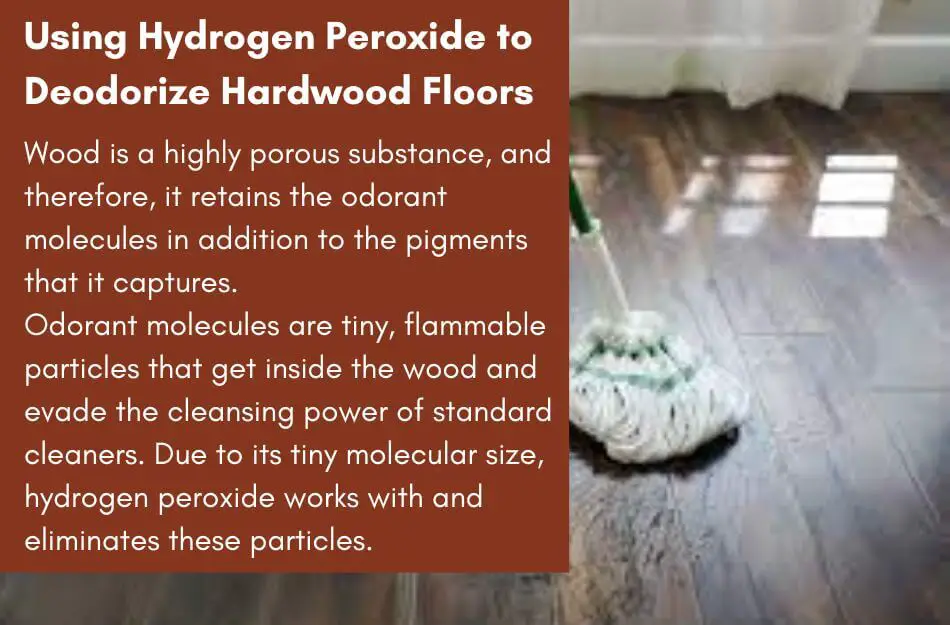
Wood is a highly porous substance, and therefore, it retains the odorant molecules in addition to the pigments that it captures.
The region may still have an offensive odor even if the stains are removed.
Odorant molecules are tiny, flammable particles that get inside the wood and evade the cleansing power of standard cleaners.
Due to its tiny molecular size, hydrogen peroxide works with and eliminates these particles.
Can Hydrogen Peroxide Be Used On All Surfaces?
Hydrogen peroxide can’t be used on all surfaces due to its strong nature which can discolor the surface.
I have written a detailed article on will Hydrogen Peroxide whiten hardwood floors that I do encourage you to read.
Due to its strong nature, it can only be used on sealed surfaces in 30% concentrated form and can be used on non-sealed surfaces in 12% concentrated form.
However, you must ensure the solution is evenly applied, as an uneven application can cause color differences.
The results with Hydrogen Peroxide are fast; hence, it won’t be long before you may realize that you have caused further discoloration.
Why You Should Use Hydrogen Peroxide on Hardwood Cleaning?
Hydrogen peroxide 3% works well, is inexpensive, and leaves wooden floors gleaming and brand-new. There are many cleaning products on the market right now.
Still, most contain dangerous chemicals that can pollute your home’s air and even hurt your hardwood floors.
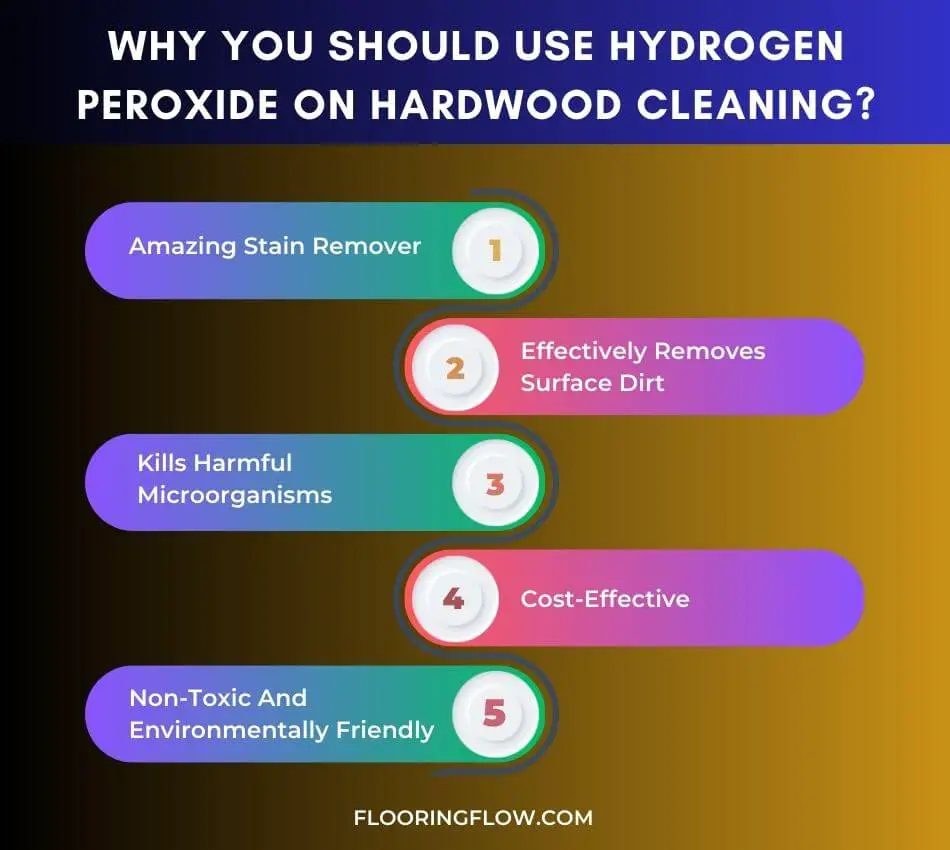
Is it okay to use hydrogen peroxide on my hardwood floors? Absolutely! While hydrogen peroxide may have a bleaching impact, it won’t lighten your floors when used in the right concentration.
Keep your hydrogen peroxide concentration at 3 percent when cleaning your hardwood surfaces. Anything beyond that wastes time and might make the timber lighter.
Amazing Stain Remover
Use hydrogen peroxide to remove tough stains and restore the appearance of your wooden floors.
Hydrogen peroxide is the best choice because it successfully cleans the wood of compounds that cause stains while drying it. Your floors won’t warp because this stops moisture harm.
Effectively Removes Surface Dirt
Specifically, Surface dirt floors become very filthy at times. You can be certain that your hardwood floors will have food, sticky drinks, and tracked mud if you include children and dogs.
Your hardwood floors will appear brand new after using hydrogen peroxide 3% to loosen and clear caked-on dirt and debris.
Kills Harmful Microorganisms
Hydrogen peroxide 3% is a powerhouse whenever it comes to cleansing your wooden floors, in addition to being great at removing dirt.
Your hardwood floors pick up a good proportion of germs like every other area in your home, particularly if you have young children and animals roaming around.
You can shield your entire family from dangerous microorganisms by using peroxide 3%, efficiently eliminating germs, infections, mold spores, bacteria, and fungi.
Even viruses and harmful microbes like staph are killed by it.
With this powerful solution, you can effectively disinfect your floors and stop the spread of minor and severe diseases. Don’t forget to go through the guide “what is a safe disinfectant for hardwood floors?“
Cost-Effective
A very cost-effective option for cleaning your hardwood floors is hydrogen peroxide 3%, which is typically less expensive than your typical heavy-duty cleaning solution.
Second, one container of hydrogen peroxide can replace several cleaning supplies.
The days of keeping a cabinet stocked with various housekeeping supplies are over. By using peroxide, you have just one option—a convenient, inexpensive, and hassle-free all-purpose remedy.
Non-Toxic And Environmentally Friendly
The fact that hydrogen peroxide is non-toxic (source) and doesn’t contain any bleach, ethyl alcohol, acids, or other hazardous chemical additives makes this substance stand out.
It shares many chemical properties with water but has an additional oxygen atom.
Hydrogen peroxide degrades entirely into only water and oxygen, which makes it secure for your entire family and the environment in contrast to conventional, chemical-filled cleaning products.
How Does Hydrogen Peroxide Work?
Hydrogen Peroxide can use this cleaning solution to sanitize and disinfect your timber floor. It eliminates surface grime and tough stains from mud, food spills, pets, and other things.
The porous surface of a hardwood floor has numerous microscopic holes that can both collect and release moisture.
For instance, buckling happens in humid areas because of the damp vapor that hardwood flooring contains.
When a porous surface consumes moisture, the pores start buckling, making removing liquid stains very challenging.
The staining substances are readily broken down by hydrogen peroxide, which removes them while drying the floor.
Additionally, hydrogen peroxide bleaches hardwood. However, it should reassure you because hydrogen peroxide will only change the color of your floor if you use an overly potent hydrogen-peroxide formula or have a dark hardwood floor.
It won’t become white. If you’re concerned that it will bleach your floor, you can try it in a hidden location (like a corner of one of your rooms).
Can Hydrogen Peroxide Be Used With a Mop on Hardwood Floors?
Cleaning hardwood floors with a mop and hydrogen peroxide is perhaps the best cleaning method to remove surface dirt from your hardwood floors and restore their luster and brightness by mopping them with hydrogen peroxide, an efficient cleaning solution.
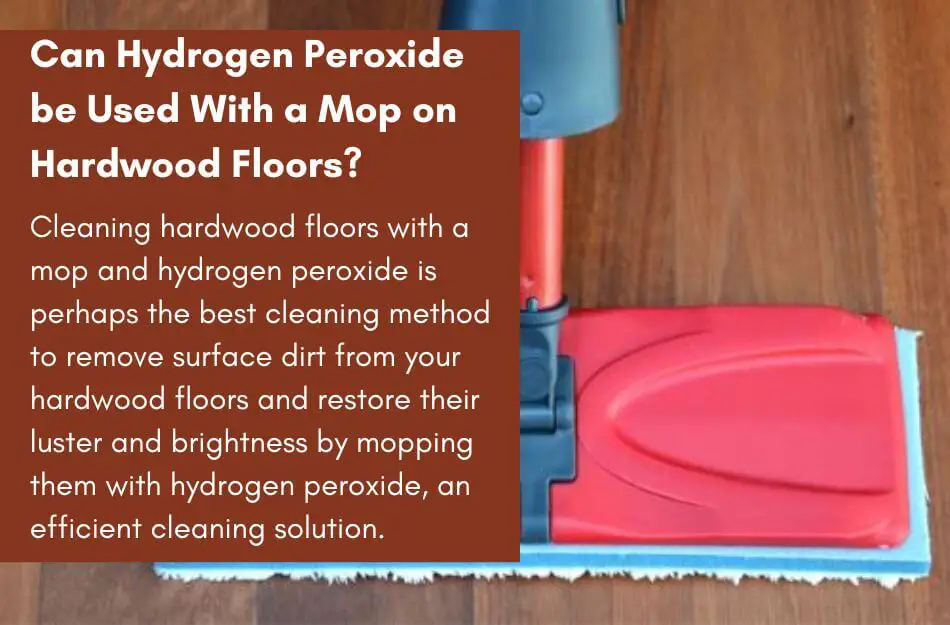
For use on wooden surfaces without causing any harm, combine a half-cup of hydrogen peroxide with a gallon of hot water.
Drying out the mop or tower is crucial to ensure it is barely damp, and then use hydrogen peroxide because too much water is bad for hardwood.
Regular fabric spreads too much water, so a soft bristle brush cloth or a microfibre mop is best.
Use mop and hydrogen peroxide to remove stubborn pet stains, hiding grime and harmful microorganisms from your parquet floor.
Will Hydrogen Peroxide Damage Hardwood Floors?
Hydrogen peroxide will not damage hardwood floors if you use it as directed; in the right concentration and with the right frequency.
Due to its potent oxidizing properties, hydrogen peroxide may have a bleaching impact.
Still, when used in the right concentrations, it won’t change the color of your wooden floors. As a result, it serves as the most reliable, efficient, and cost-efficient housecleaner.
Hydrogen peroxide in excessively high amounts can harm and brighten your gorgeous hardwood floor. Using 3% hydrogen peroxide to clean your floors is completely secure.
Hydrogen peroxide can be useful in removing stains and giving your wooden surfaces a new-like appearance if used as directed and in the recommended concentrations.
Final Thoughts
Hydrogen peroxide and wood floors are a great combination because the former maintains your home looking nice, and the latter maintains the former in good condition.
Since wooden floors are the most popular type of flooring in the US, understanding how to sanitize them is crucial.
The ideal solution is hydrogen peroxide because it thoroughly removes all stains while maintaining the condition of the surface. You must adhere to the procedure and use it with our explicit instructions.

As a co-creator of FlooringFlow.com, Emma Sophia comes on board to answer all your questions related to any flooring problems. Together with John Henry, she’s gained extensive experience in fixing many flooring problems in their own house as well as in friends and family’s. Now, she wants to share her knowledge that she gained during floor remodeling, restoring, and DIY projects.

